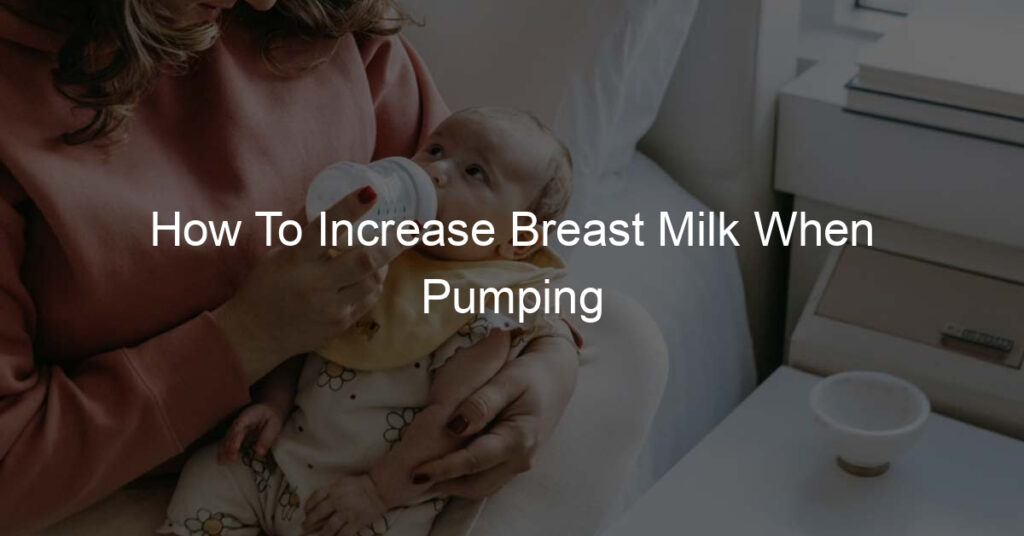It’s no secret that breastfeeding can be a challenge. Whether you’re struggling with latching, supply, or just trying to make it through another night feed, every mother needs a little help sometimes. If you’re pumping and trying to increase your breast milk production, there are a few things you can do to give yourself a boost. Here are some tips on how to increase breast milk when pumping.
Pumping schedule to increase milk supply
Establishing a consistent pumping schedule is an important part of increasing milk production for nursing mothers. This can involve figuring out how often and when to pump during the day, as well as ensuring that any stored milk is properly stored and maintained. It’s helpful to plan and create a routine that works best with one’s lifestyle, as inconsistency or gaps in pumping can reset the body’s supply-and-demand cycle.
Taking cues from a baby’s hunger and scheduling around meals can also be useful methods of creating a workable plan. With an appropriate pumping regimen, moms can expect to increase their milk supply over time through increased nursing sessions and more efficient milk expression.
How many times should I Power pump a day to increase the milk supply?
When it comes to increasing your milk supply, you may have heard about power pumping. This process simulates cluster feeding, the frequent and recurrent nursing or bottle-feeding that newborns typically require. But just how often should you power pump for optimal results?
While there is no one-size-fits-all answer, experts recommend between one to three sessions per day. Sessions should last from 20 minutes up to 30 minutes with 10-minute breaks in between each session.
With patience and dedication, mothers can experience improved milk supply within a few days of implementing a power pumping routine. Try giving it a go to discover what works best for you and your baby!
Should I keep pumping if no milk is coming out?
If you have been breastfeeding for a few months but notice that milk is no longer coming out when you pump, it may be time to reassess your approach. While pumping is essential for maintaining milk supply and keeping up with the demand of your baby, it can be counterproductive if done too often or too soon after feeding.
Making sure that your baby has had adequate time to feed can help ensure that they get the most out of each session before you move on to pumping. Additionally, set aside specific days or times each week or month dedicated only to pumping to help keep up your milk supply without overdoing it. Lastly, ensure that you switch up your routine now and then to prevent boredom while pumping and keep yourself motivated.
Overall, if you make sure not to pump more than necessary and customize a plan tailored to fit your needs as a mom, you should still be able to comfortably provide for your baby and keep up with their needs.
Cluster pumping to increase milk supply
Increasing milk supply can be a challenge for many breastfeeding mothers, especially during the early stages of nursing a baby. One method to increase milk supply is cluster pumping – a technique that involves numerous short but frequent pumping sessions during a short window of time.
This stimulates the body to produce more milk by working the same muscles in succession. Cluster pumping can also help prevent excessive leakage and discomfort between feedings and works best when done before breastfeeding, as it allows moms to save precious energy while their little one eats. All these benefits make this method an attractive option that all nursing moms should consider.
Power pumping schedule to increase milk supply
Power pumping is a technique that can be used to help boost a low milk supply when breastfeeding. It involves expressing breast milk using either a manual or electric pump at regular intervals for one to three hours. During each session, the mother pumps for ten minutes, rests for ten minutes, then pumps again repeatedly until the session is complete.
This works to stimulate the body’s production of oxytocin and prolactin, hormones responsible for controlling milk supply. Overall, while results may vary depending on the individual, power pumping can present an effective supplement during times of lower-than-desired milk production.
Closing Thoughts: How To Increase Breast Milk When Pumping
Overall, getting your partner involved in the process of pumping and increasing your breast milk supply can be a great way to make it easier on both mother and baby. It’s important to remember that there is no one-size-fits-all answer; different mothers may need different combinations of methods and tips to find the one that works best for them.
Everyone’s body is unique and you must figure out what works for you that best fits your lifestyle. Testing out different pieces of advice like relaxation, oxytocin, lactation massages, taking supplements, drinking lots of water, trying out herbs/medications, getting plenty of rest, and engaging in power pumping should help increase your breast milk supply when you are exclusively pumping.
Giving yourself grace in this process is just as important as any other steps you take – doing something toward increasing your supply doesn’t mean you have to do everything perfectly all the time. Above all else, trust and listen to your body and know that you have done enough even if things don’t work out as planned!














